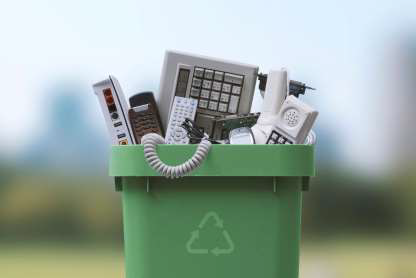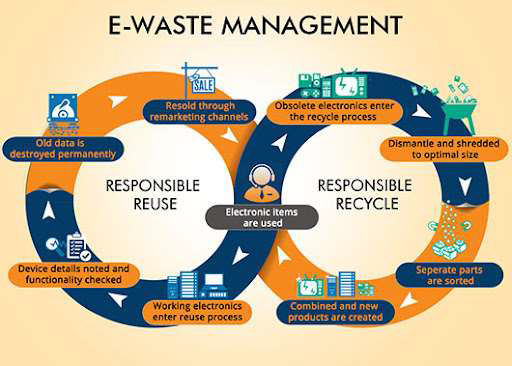INTRODUCTION
E-waste, or electronic waste, refers to discarded electrical or electronic devices that are no longer in use or functional. With rapid technological advancements and the increasing demand for electronic products, the volume of e-waste has surged globally. This rise poses significant environmental and health risks, making e-waste management a critical issue that requires immediate attention. This paper explores the causes, impacts, and solutions related to e-waste.
CAUSES OF E-WASTE GENERATION
One of the primary reasons for the increase in e-waste is the rapid obsolescence of electronic devices. Manufacturers frequently release upgraded models, compelling consumers to replace their older devices even if they are still functional. Additionally, the growing affordability of electronics has led to increased consumption and disposal rates. The lack of robust recycling and disposal policies in many regions further exacerbates the problem.
Another contributing factor is planned obsolescence, where companies design products with a limited lifespan to encourage frequent upgrades. This practice results in excessive waste as consumers discard electronics that could have been used for a longer period. Furthermore, the global digital divide means that while developed nations discard outdated electronics, developing countries often receive these as second-hand goods, which eventually add to their e-waste burden.
ENVIRONMENTAL AND HEALTH IMPACTS
E-waste contains hazardous materials, including lead, mercury, cadmium, and brominated flame retardants, which can leach into the environment if not disposed of properly. These toxic substances contaminate soil, water, and air, posing severe ecological threats. For instance, heavy metals can seep into groundwater, affecting drinking water sources and aquatic ecosystems.
Improper e-waste disposal also leads to harmful air pollution. Burning electronic components releases toxic fumes, contributing to respiratory issues and air pollution. Additionally, informal recycling sectors in many developing countries expose workers to hazardous substances without proper safety measures, leading to severe health conditions such as neurological disorders, respiratory diseases, and cancer.
CURRENT E-WASTE MANAGEMENT PRACTICES
E-waste management varies across countries, with some having advanced recycling systems while others struggle with improper disposal. Developed nations have established regulations such as the Waste Electrical and Electronic Equipment (WEEE) Directive in the European Union and the Resource Conservation and Recovery Act (RCRA) in the United States. These laws aim to promote recycling, proper disposal, and manufacturer responsibility.
However, many developing countries lack formal recycling infrastructure, leading to informal recycling practices that pose risks to both human health and the environment. Scavengers often dismantle electronics manually, exposing themselves to toxic elements without protective gear. Additionally, a significant portion of e-waste is illegally exported to countries with weaker regulations, exacerbating the global crisis.
SOLUTIONS AND RECOMMENDATIONS
Extended Producer Responsibility (EPR): Manufacturers should be held accountable for the entire lifecycle of their products, including take-back and recycling programs. This strategy incentivizes the production of more sustainable and easily recyclable electronics.
Consumer Awareness and Participation: Educating consumers about responsible ewaste disposal and the importance of recycling can lead to better practices. Encouraging the donation of functional electronics and the proper disposal of non-functional ones can reduce waste generation.
Stronger Regulations and Enforcement: Governments should enforce stringent ewaste management laws, including bans on illegal dumping and exports. Policies should also support formal recycling industries to provide safe working conditions and environmentally sound disposal methods.
E-Waste in India
- India ranks as the third-largest producer of e-waste globally, generating approximately 3.2 million tons annually.
- Between 2010 and 2022, the country experienced a 163% increase in e-waste from screens, computers, and small IT and telecommunication equipment.
- Despite governmental efforts to enhance e-waste collection, less than one-third of the waste was recycled as of 2022, underscoring the need for improved infrastructure and public awareness.
E-Waste in Chennai
Chennai, as a major urban center, contributes significantly to India's e-waste. Several authorized e-waste recycling companies operate in the city, offering services like data destruction, device refurbishment, and material recovery. Notable recyclers include:
- Sree E-Waste Recycling: Provides comprehensive recycling solutions, ensuring environmentally responsible disposal of electronic items.
- BV Recyclers: Equipped with state-of-the-art facilities to handle various electronic devices, promoting resource conservation.
- SKV E-Waste Recycling Pvt. Ltd.: Specializes in recycling electronic goods through advanced processes, aiming to protect the environment.
CONCLUSION
E-waste is a pressing global issue that requires immediate and collective action. The rapid technological advancements that drive economic growth should not come at the cost of environmental degradation and human health risks. By adopting sustainable practices, strengthening regulations, and promoting responsible consumer behavior, we can mitigate the impacts of e-waste and move towards a more sustainable future. The responsibility lies with all stakeholders—governments, corporations, and individuals—to ensure that electronic products are managed responsibly from production to disposal.
Author Bios:
1. Mr MADANACHITRAN.R, AP/CSE
2. Dr. ARIVUKARASI M, ASP/CSE
3. RAMAKRISHNAN P, IV-CSE
4. NANDHITHA SHRI K K. IV-CSE



Comments
Post a Comment